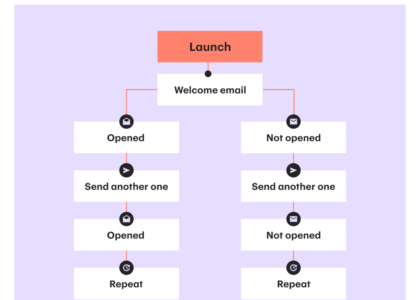So You Want to Fix Your Bounce Rates in 2025 and Finally Get More of Your Emails Actually Delivered?
Smart move.
While everyone’s chasing engagement hacks on TikTok, scrambling to understand AI tools, or A/B testing Instagram hooks for the hundredth time… the marketers who actually get results are paying attention to something less flashy but way more important: email deliverability.
Maybe you’re already sending campaigns, automations, even flows that should be killing it. But the results feel off – your open rates are weirdly low, click-throughs are here today, gone tomorrow and you’re wondering why a solid list just isn’t pulling its weight.
What most brands completely miss is your bounce rate can silently tank your results. Because here’s the truth – none of that clever copy, fancy design, or sales psychology inside your emails will matter if your messages aren’t even landing in inboxes. And that’s where bounce rates come in.
In 2025, with tighter inbox filters, new Gmail and Apple rules, and smarter spam traps, email bounce rates are now a make or break signal for your sender reputation, your revenue, and your entire email marketing program.
Let’s make that make sense real quick…
So back in the day, you could get away with a few bounced emails here and there. Maybe the list was old, maybe the email address had a typo. No big deal, right?
Not anymore.
Now, high bounce rates signal ISPs (like Gmail or Outlook) that you’re either sloppy with your data… or possibly even a spammer. And when that happens, the punishment is brutal: Your domain gets flagged. Your sender score tanks. Your emails stop reaching everyone – not just the bounces. And that, friend, is the beginning of the end for your email ROI.
It doesn’t matter if you’re selling candles, coaching programs, or SaaS tools – if your emails don’t land, they don’t convert. Period.
That’s why we wrote this blog for the brands and marketers who want to fix bounce issues for good. You’re not here to panic every time a campaign underperforms or guess why your inbox placement is tanking. You’re here to understand how this works, fix your systems, and get back to doing what you do best: sending emails that actually land, get opened, and gets results.
This is your 2025 deliverability playbook, packed with practical strategies to improve your email ROI and so you can trust that we’re not just going to tell you “clean your list” and call it a day.
By the end of this, you’ll know exactly why bounce rates happen, how to spot the real problem behind them and the 10 proven ways to fix them before they ruin your reach
Let’s get into it.
The 10 BEST STRATEGIES to Minimize Your Email Bounce Rate
Before we get into strategy, automation, and engagement hacks, let’s talk about something far more fundamental – whether your emails are even making it to inboxes in the first place. See, great subject lines and clever copy mean nothing if deliverability is broken, and the fastest way to break it is by ignoring your bounce rate.
A high bounce rate isn’t just a glitch in the matrix; it’s a warning light on the dashboard that your domain reputation might be dying quietly in the background – sometimes without you even noticing until your open rates start dropping or your messages begin skipping inboxes altogether. But to fix bounce problems, you first have to understand what they actually are – and not just at a surface level.
There are four main types of bounces, and each one tells a slightly different story.
- Hard Bounce: A hard bounce happens when you send to an address that doesn’t exist or can’t ever receive mail again. Think deactivated accounts, fake signups, or flat-out typos like “gmial.com.” Hard bounces should be removed immediately. If you keep emailing them, inbox providers see you as careless or worse, malicious.
- Soft Bounce: Temporary issue. Could be that the recipient’s inbox is full, their server is down, or your message was too large. Soft bounces might resolve on their own, but if an address soft-bounces multiple times, you should treat it like a hard bounce.
- Blocked: This means your message was rejected outright by the recipient’s server. Why? It could be due to poor IP reputation, sketchy content, domain issues, or lack of authentication. Blocks are often early warning signs that your sender reputation is degrading.
- Invalid Address: This category usually overlaps with hard bounces, but it specifically refers to email addresses that were never valid to begin with. These creep into your list through form typos, bot signups, or shady list purchases.
And this brings us to why this matters. Inbox providers like Gmail, Outlook, Yahoo track your sending behavior. So every bounce counts against you in their invisible scoring systems, and the more often you send to bad addresses, the more you look like a spammer, even if your intentions are clean.
Over time, this degrades your sender reputation, a kind of digital credit score that determines how likely you are to land in the inbox versus the spam folder. It also affects your domain health, because when your bounce rate rises consistently, you risk being flagged or blacklisted – which impacts not just your marketing emails but potentially even your transactional ones like order confirmations and password resets.
That’s not fear-mongering – it’s just how the ecosystem works. So if you’re still thinking of bounce rate as a minor metric buried in your campaign report, it’s time to reframe it as a leading indicator of your email channel’s long-term viability.
Now that we’ve broken down what email bounces are and why they’re more than just an annoying stat, it’s time to get practical. Let’s get into 10 proven strategies to help you avoid bounces altogether, protect your sender reputation, and boost your inbox placement. Whether you’re just starting out or scaling up your campaigns, these actionable tips will future-proof your email list and maximize your deliverability in 2025 and beyond.
Strategy #1: Use Verified Email Lists Only
There’s a dangerous shortcut that still lingers in too many B2B marketing playbooks: buying cold lists. On paper, it seems efficient – a quick way to bulk up your outreach. But here’s the truth in 2025: purchased lists are deliverability grenades. They’re bloated with expired, unverified, or fake contacts that send your bounce rate skyrocketing and your sender score plummeting. It’s not just a bad look; it’s a fast track to spam folders, domain penalties, or full blacklisting.
So what does “verified” actually mean now? A verified list isn’t just a cleaned-up spreadsheet with emails that “look” real. In 2025, it means the contacts were tested for validity, confirmed to be active, and in many cases, recently engaged with relevant campaigns. Look for list providers who offer triple verification (format check, SMTP ping, and engagement scoring) and who will stand behind their data with bounce guarantees.
Before you upload any list into your ESP, pause and run it through this quick 3-step checklist:
- Has it been verified within the last 60 days?
- Are the contacts relevant to your audience today – not 3 years ago?
- Does it come with opt-in documentation or evidence of compliance?
If the answer to any of those is “no” or “not sure,” don’t put your deliverability at risk.
Strategy #2: Regularly Clean Your Email Lists
Even the cleanest list will rot over time. People switch jobs, abandon inboxes, or delete accounts altogether. What starts as a goldmine of potential quickly becomes a minefield of bounces and spam traps. The fix is making sure that list hygiene isn’t a one-time event – make it a discipline.
Now I know some of you are asking, how often is enough in 2025? The rule of thumb is every 30 – 60 days, depending on how frequently you email. If you’re running weekly sends or automation-heavy flows, go monthly. If it’s a light-touch list, quarterly may suffice. But go longer than that, and you’re playing with fire.
Fortunately, automation makes this easy. Tools like NeverBounce, BriteVerify, Emailable, and ZeroBounce now integrate directly into platforms like Mailchimp, Klaviyo, and ActiveCampaign. Some even work pre-send, automatically flagging risky addresses before a blast goes out.
Now there’s this question of should you delete bad emails or just suppress them? The answer depends. Hard bounces and known spam traps should be suppressed immediately. But soft bounces or inactive users you can put through a re-engagement campaign first. If they still ghost you after 2-3 attempts, then yes – it’s time to say goodbye.
Strategy #3: Use Confirmed (Double) Opt-In
There’s no way around it: single opt-in is risky. You’re essentially inviting typos, bots, and fake leads into your system, all of which turn into bounces later – sometimes months down the line when it’s too late to undo the damage. In 2025, double opt-in isn’t just best practice, it’s what inbox providers expect from serious senders.
But let’s be honest: most brands avoid it because they think it kills conversions but that’s only true when double opt-in is done wrong – like burying the confirmation email, using dry language, or failing to explain why it’s necessary.
One way you can design a frictionless flow is to send an immediate confirmation email, branded and friendly, with a clear “tap to confirm” button. Now if you offer a reward or benefit for confirming, like access to gated content, a welcome coupon, or an exclusive freebie, you can get people to confirm, and take an extra action.
Now what if your list is already single opt-in? You’ve got two options: either re-confirm old contacts through a targeted re-engagement campaign or start fresh segments that follow a stricter double opt-in process. Either way, the goal is the same – reduce bounce risk and improve quality.
Strategy #4: Improve Email Collection at the Source
Most bounce problems don’t start with delivery, they start at data entry. If your opt-in forms allow users to input garbage data, that’s exactly what you’ll get. So instead of relying on post-send tools to clean things up, start by preventing bad emails from entering your system at all.
And the first way to do that is smart validation with tools like Kickbox, AtData, and Clearout which can instantly verify format, syntax, and even ping the mailbox in real time – right as someone types it into your signup form. Now if you have the ability to use autocomplete suggestions (especially for common domains like Gmail or Outlook), you cut typo rates dramatically which by extension cuts down bad data.
We usually get plagued with bots just signing up on our form and the one smart way to keep bots out is to add honeypot fields – hidden form fields that only bots will see and fill out. If a submission includes that field, it’s a bot. Simple. And if you want to add a creative touch to your data collection process, try gamified opt-ins like spin-to-win wheels, scratch cards, or quiz funnels. These improve engagement, yes, but also accuracy because people pay more attention when they’re playing a game.
When you collect cleaner data, you don’t just avoid bounces, you improve your entire email ROI.
Strategy #5: Authenticate Your Domain (SPF, DKIM, DMARC)
The year is 2025 and authentication isn’t optional. You have to get this all set up. With Gmail and Apple doubling down on sender transparency, any domain without SPF, DKIM, and DMARC properly set up is going to see brutal inbox placement issues in 2025. Some emails may not even get delivered at all.
Let’s break it down:
- SPF (Sender Policy Framework) is like a guest list – it tells inboxes which servers are allowed to send on your behalf.
- DKIM (DomainKeys Identified Mail) signs your emails with a digital signature to prove they haven’t been tampered with.
- DMARC sets what should happen if an email fails SPF or DKIM, and where to send the reporting.
Every domain registrar looks different, but it’s really the same setup. You’ll log in to your domain registrar (like GoDaddy or Namecheap) and navigate to the DNS management section. and add the following:
- SPF: Add a TXT record like this: v=spf1 include:sendgrid.net ~all (Replace sendgrid.net with your actual email service provider.
- DKIM: Generate a DKIM key pair usually provided by your ESP. You’ll paste in a TXT record that looks like a long string of code. This validates your email signature.
- DMARC: Start with a record like this: v=DMARC1; p=none; rua=mailto:dmarc@yourdomain.com . Later, you can change p=none to p=quarantine or p=reject once you’re confident things are set up properly.
Most ESPs have wizards or setup instructions to configure these in your DNS settings. But you have to verify that they’re working. Use tools like MxToolbox, Google Postmaster Tools, or DMARC Analyzer to audit your domain. Set them once, and you build a foundation of trust for every send that follows.
Strategy #6: Send from a Reputable, Consistent IP and Domain
Your sender reputation isn’t just tied to your content, it’s also tied to your IP and domain history which is why shared IPs are a gamble. If someone else on that IP behaves badly, you share the consequences. In 2025, if you’re sending at scale, you need a dedicated IP or at least a high-reputation shared pool with good governance.
Now for some of you just starting out, you want to warm up your new domain. The best way to do it is to start with low-volume sends, ramp up over 2 – 4 weeks, and mix in high-engagement segments to build positive signals. If you blast a cold domain to thousands of contacts, you’re almost guaranteed to trip spam filters or get flagged as suspicious.
Sudden surges in send activity especially to cold or purchased lists can trigger Inbox providers to interpret this inconsistency as risky. In email, trust is built over time and lost in seconds. You can learn more about it in our blog on How to Keep Your Emails Out of the Spam Folder and Get Seen Every Time
Strategy #7: Avoid Spam Triggers and Poor Sending Practices
The type of content you’re sending still matters, so if your subject line screams “FREE!!!” and your body copy is stuffed with ALL CAPS, shady links, or sketchy promises, you’ll end up in spam or worse, blocked entirely. In 2025, spam filters have evolved beyond keyword detection and now go as far as factoring in engagement history, formatting, URL reputation, and even image-to-text ratios.
One way to get around this and be on the safe side is to avoid;
- Words like “Act now,” “100% guaranteed,” “Buy direct,” “Click here.”
- Excessive exclamation marks or ALL CAPS SUBJECT LINES.
- Link shorteners like bit.ly unless they’re branded or authenticated.
And keep your design tight – this means using mobile-optimized layouts, alt text on images, and a clear text-to-image balance. Spam filters hate image-only emails and they also penalize mismatched domains meaning if your email has only images or links to multiple, unrelated domains, that’s a red flag. Ultimately, deliverable emails are emails that look human, relevant, and trustworthy.
Strategy #8: Monitor Engagement and Prune Inactive Contacts
Even a squeaky-clean, 100% verified list can still tank your deliverability if it’s full of silent subscribers. Why? Because inbox providers (like Gmail, Outlook, Apple) are watching how people interact with your emails. No opens, no clicks, no replies? That’s a red flag. They start assuming your emails don’t matter and suddenly you’re landing in the promo tab or, worse, the dreaded spam folder.
So if you want to keep hitting the inbox consistently, you can’t just clean for bounces, you have to also clean for engagement.
Here’s what that looks like:
- Watch your open and click rates by segment, especially those 60 to 90 days cold.
- Don’t ghost them immediately. Instead, drop them into a 3-touch win-back sequence.
- Use subject lines that feel human, not robotic. Try:
- “Still want to hear from us?”
- “We’re cleaning house – stay or go?”
- “Your inbox, your rules. Just let us know.”
If they open or click? Great, you can keep the convo going. If they don’t? Let them go with love. Suppress them from future sends and protect the quality of your list. This isn’t personal. You’re just protecting your deliverability. Because in 2025, engagement is king!
Strategy #9: Set Up Bounce Handling Rules and Automations
If you’re still manually checking bounce logs, stop. It’s 2025. Your system should be doing this for you. Most modern ESPs let you automate bounce handling with rules like:
- After 1 hard bounce → suppress immediately
- After 2 soft bounces → suppress for 30 days
- After 3 soft bounces → suppress permanently
But automation is only part of it. You also need a suppression list – a dynamic list of contacts that should never be emailed again, regardless of what other list they’re on. This protects your sender score and ensures no accidental sends to risky addresses.
Now we always recommend our readers and clients sync their suppression list across – CRM, sales tools, retargeting platform, all of it. If a contact hard bounces in your main ESP, they should also be flagged everywhere else
Strategy #10: Work With a High-Deliverability ESP
So every email platform is different. Some prioritize a great User Interface and drag-and-drop builders over the infrastructure that actually gets your email delivered. In 2025, you want an ESP that’s obsessively focused on deliverability, inbox placement, and sender reputation management. You want providers that offer:
- Built-in list hygiene tools
- Deliverability dashboards
- Dedicated IP options
- Strong authentication support
- Access to Postmaster Tools and Feedback Loops
A huge run-for-the hills red flag is when providers don’t help with warm-up plans, don’t block known spam traps, or have poor shared reputations. For the average Joe, knowing what platform offers high-deliverability can be confusing so here are some ESPs that do just that:
- Mailgun (for dev teams)
- Postmark (for transactional + fast delivery)
- ConvertKit (for creators, high open rates)
- ActiveCampaign (for automation + engagement scoring)
- Klaviyo (for eCommerce with built-in hygiene tools)
Whatever ESP you choose should be more than just easy to use – it should be strategic. Your platform is your partner in deliverability. It should have your back with proactive monitoring, smart suppression handling, and real-time feedback when things go sideways. Think of it like this: you’re building a Formula 1 email engine. Would you rather race with a pretty dashboard, or one that actually wins?
If you’ve made it this far, you’re not here to play small. You want your emails to not just land in someone’s inbox but actually get read and acted on – Contact Abervin Digital at +1 307-271-5184 or visit Abervin Digital to check out our pricing and packages or learn how we can transform your email list into a growth machine..






